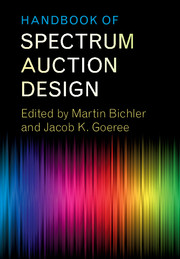Book contents
- Frontmatter
- Contents
- List of Contributors
- Preface
- List of Papers
- Part I The Simultaneous Multiple-Round Auction
- Part II The Combinatorial Clock Auction Designs
- Part III Alternative Auction Designs
- Part IV Experimental Comparisons of Auction Designs
- Part V The Bidders’ Perspective
- Part VI Secondary Markets and Exchanges
- Outlook
Preface
Published online by Cambridge University Press: 26 October 2017
- Frontmatter
- Contents
- List of Contributors
- Preface
- List of Papers
- Part I The Simultaneous Multiple-Round Auction
- Part II The Combinatorial Clock Auction Designs
- Part III Alternative Auction Designs
- Part IV Experimental Comparisons of Auction Designs
- Part V The Bidders’ Perspective
- Part VI Secondary Markets and Exchanges
- Outlook
Summary
The 1994 sales of spectrum for “personal communication services” (PCS) marked a sharp change in policy by the US Federal Communications Commission (FCC), which had allocated spectrum for free until then. The PCS auction was designed by Stanford professors Paul Milgrom and Robert Wilson. The July auction with just ten licenses raised over $600 million while the December auction raised more than $7 billion, breaking all records for the sale of public assets in the US and leading the New York Times to hail it as “the greatest auction ever.” Substantial revenues are an obvious benefit but even more important is the fact that the PCS auction allocated this valuable public asset efficiently. By forcing firms “to put their money where their mouths are” the PCS auction selected firms that could utilize spectrum the best – to the greater benefit of society. Milgrom and Wilson's design has since been adopted by many regulators and has generated hundreds of billions of dollars for treasuries worldwide.
The PCS auction was organized as a simultaneous multiple-round auction (SMRA), which is also known as a simultaneous ascending auction (SAA). The SMRA is a simple but flexible format to sell multiple licenses in parallel. Despite the simplicity of its rules, the SMRA may create strategic difficulties for bidders interested in acquiring combinations of licenses. Since licenses have to be won one-by-one in the SMRA, bidders who compete aggressively for a desired combination risk winning an inferior subset at high prices. This is known as the exposure problem. Foreseeing the possibility of being exposed, bidders may act cautiously with adverse effects for revenue and efficiency.
Combinatorial auctions solve the exposure problem by allowing for bids on combinations of licenses. While this feature has the potential to improve efficiency, it also leads to new design challenges such as the computational hardness of the allocation problem, or the combinatorial growth in the number of package bids in some auction formats. Spectrum auction design has seen several recent innovations such as the single-stage and two-stage combinatorial clock auction (CCA), hierarchical package bidding (HPB), or sealed-bid combinatorial auctions.
- Type
- Chapter
- Information
- Handbook of Spectrum Auction Design , pp. xiii - xviiiPublisher: Cambridge University PressPrint publication year: 2017

